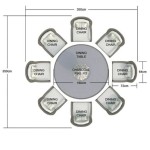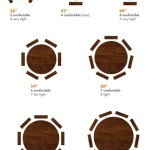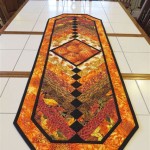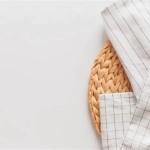The Purpose of Table Napkin Folding
Table napkin folding, often perceived as a purely decorative element in dining settings, serves a multifaceted purpose extending beyond mere aesthetics. While the visual appeal of an artfully folded napkin undeniably enhances the overall dining experience, the practice is rooted in functionality, hygiene, and historical tradition. Understanding the various reasons behind napkin folding reveals its significance in both formal and informal settings.
The practice of using napkins has ancient roots, with rudimentary forms appearing in ancient Greece as "apomagdalie," pieces of dough used to wipe hands. As civilizations progressed, cloth napkins became increasingly common among the affluent, signifying status and refinement. Folding these napkins evolved alongside societal customs, becoming an integral part of formal dining etiquette. The elaborate folds denoted a level of sophistication and attention to detail from the host, contributing to the overall atmosphere of the occasion. This historical context provides a foundation for understanding the modern purposes that table napkin folding addresses.
Enhancing Aesthetics and Ambiance
One of the primary purposes of table napkin folding is to enhance the visual appeal of a dining setting. A carefully folded napkin adds a touch of elegance and sophistication to the table, creating a more inviting and enjoyable atmosphere for diners. The choice of fold can complement the overall theme or style of the meal, whether it is a formal dinner party, a casual brunch, or a festive holiday gathering. A simple triangular fold might suit a relaxed setting, while a more elaborate design, such as a rose or a fan, could be used for a formal event.
The color and material of the napkin also play a significant role in the aesthetic impact. Linen napkins, often preferred for their durability and luxurious feel, are available in a wide range of colors, allowing for coordination with the tablecloth, dinnerware, and other table decorations. The visual harmony achieved through thoughtful napkin selection and folding contributes to the overall sensory experience of the meal, making it more memorable and enjoyable for the guests.
Beyond individual aesthetics, napkin folding can also be used to create a sense of occasion. Special folds can be employed for holidays, birthdays, or other celebrations, adding a festive touch to the table. For example, a Christmas tree fold might be used during the holiday season, or a heart fold could be used for a romantic dinner. The use of themed napkin folds demonstrates attention to detail and a desire to create a special experience for the diners.
Furthermore, the act of folding a napkin can be considered an art form in itself. Experienced individuals can create intricate and elaborate designs that showcase their skill and creativity. These artistic folds can be particularly impressive at high-end restaurants and formal events, where they contribute to the overall sense of luxury and refinement. The attention given to the presentation of the napkin reflects the care and consideration given to all aspects of the dining experience.
Ensuring Hygiene and Practicality
Beyond its aesthetic role, table napkin folding serves a crucial function in maintaining hygiene and providing practicality during a meal. The primary purpose of a napkin is to protect clothing from spills and to provide a clean surface for wiping hands and mouths. A well-folded napkin ensures that it is readily available and easily accessible for these purposes throughout the meal.
The size and shape of the folded napkin influence its practicality. A larger napkin, when properly folded, provides more coverage and protection than a smaller one. Certain folds, such as the pocket fold, create a convenient pouch for holding silverware, preventing direct contact with the table and ensuring a clean dining surface. This is especially important in environments where hygiene is paramount.
The placement of the napkin on the table also contributes to its functionality. Typically, the napkin is placed to the left of the forks or on the plate itself. This placement provides easy access for the diner and signals its intended use. In more formal settings, the napkin may be draped partially over the edge of the table, allowing for discreet wiping without disrupting conversation or formal posture.
The material of the napkin also plays a role in its hygiene. Linen and cotton napkins are absorbent and can effectively wipe away spills and crumbs. These materials are also washable and reusable, making them a more sustainable and hygienic option compared to disposable paper napkins. The use of clean, well-maintained napkins is essential for preventing the spread of germs and ensuring a safe and sanitary dining experience.
Moreover, some napkin folds can facilitate ease of use. Folds that allow the napkin to be easily unfolded and spread across the lap are particularly practical. The goal is to provide a functional tool for maintaining cleanliness without requiring excessive effort or causing disruption. The design of the fold should prioritize accessibility and usability, ensuring that the napkin effectively serves its intended purpose.
Conveying Etiquette and Social Signals
Table napkin folding is deeply intertwined with dining etiquette and serves as a subtle form of communication between the host and the guests. The way a napkin is folded and placed reflects the formality of the occasion and communicates expectations regarding proper dining conduct. Understanding these unspoken rules contributes to a more comfortable and respectful dining experience.
In formal settings, the placement and style of the napkin fold often adhere to specific conventions. A complex and meticulously folded napkin signals a high level of formality and attention to detail. Guests are expected to handle the napkin with care, unfolding it discreetly and placing it on their laps at the beginning of the meal. The proper use of the napkin throughout the meal, such as dabbing the mouth instead of wiping, is also an important aspect of dining etiquette.
Conversely, in more casual settings, the napkin folding may be simpler and less formal. A straightforward fold or a rolled napkin indicates a relaxed atmosphere where strict adherence to etiquette is not expected. Guests are generally given more leeway in how they use the napkin, although basic principles of cleanliness and courtesy still apply.
The way a guest handles the napkin during and after the meal also conveys specific social signals. Placing the napkin on the chair when leaving the table temporarily indicates that the diner intends to return. Placing the napkin loosely to the left of the plate at the end of the meal signals that the diner has finished eating. These subtle cues help the waitstaff understand the guests' intentions and provide appropriate service.
Furthermore, the absence of a napkin or the use of a disposable paper substitute can also convey a message about the formality of the event. In very casual settings, such as picnics or outdoor barbecues, paper napkins are often used for convenience. However, in most other settings, the use of cloth napkins is preferred, as it demonstrates a higher level of consideration for the guests and elevates the overall dining experience. The choice of napkin material and folding style is therefore an important aspect of setting the tone for the meal.
In conclusion, the purpose of table napkin folding extends far beyond mere decoration. It serves to enhance the aesthetics of the dining setting, ensuring hygiene and practicality, and conveying essential etiquette and social signals. By understanding the various functions of napkin folding, individuals can appreciate its significance in both formal and informal dining experiences.

Table Elegance Mastering The Skill Of Napkin Folding Ownkoti

Pendant Fold Napkin Technique Like An Expert Bumblebee Linens

How To Make A Triple Pocket Napkin Fold Easy Guide Tips

How To Fold Your Holiday Napkin Like A Fir Tree Shockingly Delicious

Napkin Folding History Facts Instructions 2025

Folding A Napkin Into Pinwheel

Candle Napkin Fold Food And Tools

Napkin Etiquette Table Manners
:max_bytes(150000):strip_icc()/a98917_1101_lotus_xl-7c62cdf1e36c44ef958623e16d48d274.jpg?strip=all)
How To Fold Napkins In 13 Ways

How To Fold A Dinner Napkin The Pyramid Noble Pig
Related Posts








